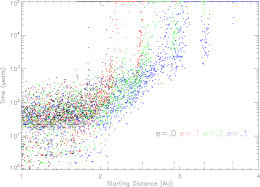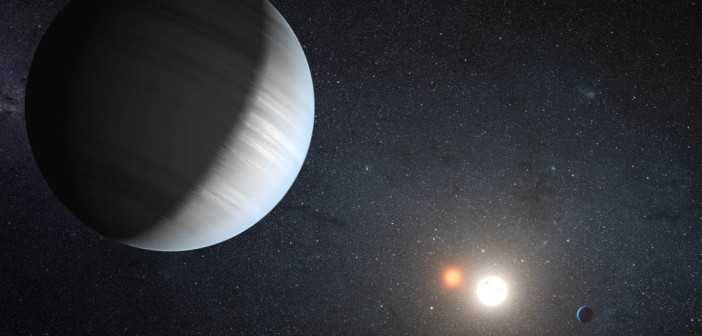What happens to Tattooine-like planets that are instead in unstable orbits around their binary star system? A new study examines whether such planets will crash into a host star, get ejected from the system, or become captured into orbit around one of their hosts.
Orbit Around a Duo
At this point we have unambiguously detected multiple circumbinary planets, raising questions about these planets’ formation and evolution. Current models suggest that it is unlikely that circumbinary planets would be able to form in the perturbed environment close their host stars. Instead, it’s thought that the planets formed at a distance and then migrated inwards.
One danger such planets face when migrating is encountering ranges of radii where their orbits become unstable. Two scientists at the University of Chicago, Adam Sutherland and Daniel Fabrycky, have studied what happens when circumbinary planets migrate into such a region and develop unstable orbits.
Producing Rogue Planets

Time for planets to either be ejected or collide with one of the two stars, as a function of the planets’ starting distance (in AU) from the binary barycenter. Colors represent different planetary eccentricities. [Sutherland & Fabrycky 2016]
The authors find that the most common fate for a circumbinary planet with an unstable orbit is ejection from the system; over 80% of unstable planets were ejected. This has interesting implications: if the formation of circumbinary planets is common, this mechanism could be filling the Milky Way with a population of free-floating, “rogue” planets that no longer are associated with their host star.
The next most common outcome for unstable planets is collision with one of their host stars (most often the secondary), resulting in accretion of the planet onto the star. Only rarely do unstable planets make it through the 10,000-yr integration without being removed from the system via ejection or collision.
Tidal Effects
As a final experiment, the authors also added the effects of tidal stripping, which occurs when the stars of the binary tear away some of the planets’ mass during close encounters. They found that this alters the orbit of the planets that have close encounters with one of the stars, making it slightly more likely that they can be captured around a star.
How can we test these models? When a star tidally strips a planet or accretes a planet in a collision, this process leaves its mark on the star in the form of stellar pollution. By comparing the amount of planetary material in the two stars of a binary, it may be possible to confirm the rates predicted here — thereby answering the question of what happens to unstable Tattooines.
Citation
Adam P. Sutherland and Daniel C. Fabrycky 2016 ApJ 818 6. doi:10.3847/0004-637X/818/1/6

1 Comment
Pingback: Tatooine planets likely only last 10,000 years